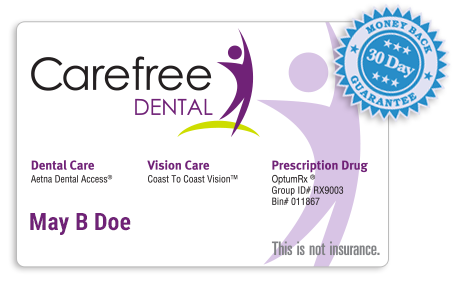How Much Does A Dental Filling Cost Without Carefree Dental?
Dental providers set their own prices, so the only way to know for sure how much a dental filling will cost at a specific provider is to give them a call and ask. That said, the price for dental fillings will generally be in the $100-$250 range (according to Your Dentistry Guide).
Why such a large price range? One reason is that there are actually two types of dental fillings, amalgam (metal) fillings and resin-based composite fillings. You’ll learn more about these two types of fillings later on in this article, but for now what you need to know is that amalgam fillings cost around $110-$220 each, while composite fillings are more expensive at $135-$240 each.
Keep in mind, the price for dental fillings does not include the cost of your oral exam ($76) or cleaning ($130). Every cavity filling must be preceded by an oral exam, because the exam is where the dentist locates the cavity in the first place.
All together, these three services will cost about $417 on average--and that’s a lot of money for anyone!
How much can you save with Carefree Dental?
If you’re looking for a discount dental filling, you can’t go wrong with Carefree.
The Carefree Dental Discount Card will save you 15-50% per
visit*, in most instances, on your dental expenses, and on
average you’ll save 51% on dental fillings. That brings the cost
down from $211 to $104. And when you look at the whole cost
(including your oral exam and cleaning), Carefree can bring the
cost down from $417 to a much more manageable $208--saving you an
impressive 50% overall.
But that’s not all!
Unlike dental insurance, Carefree Dental family membership works for your entire household. That’s right, you can use one card to get a discount on dental fillings for yourself, your spouse, and all your children.
So if more than one person in your household has a cavity--both
of your kids, for example--then your savings multiply. With two
cavities to fill, you’d save $416. With three cavities, you’d
save $624.
Is Carefree Dental the Best Discout Dental Plan for Fillings?
When you’re searching for help to pay for dental expenses, the choices can seem overwhelming. Should you sign up for insurance? Ask your provider if they offer payment plans for dental fillings? Or should you opt for Carefree Dental?
Here are some of the pros and cons of your options:
Dental insurance. Dental insurance comes with a steep monthly fee of $20-$50 or more per month, and often requires dental filling out lots of paperwork to sign up and file a claim. On top of that, insurance doesn’t cover every procedure (cosmetic procedures, for instance, often are not covered), has an annual savings cap (limiting your benefits to $1,000-$1,500 per year), and often still requires you to pay a percentage for any non-routine dental care.
Pay out-of-pocket. Paying out-of-pocket for your dental expenses is a risky move. If anything expensive comes up, such as needing a dental filling or a crown, you could be on the hook for hundreds or even thousands of dollars. For most people, that just isn’t an affordable option.
Carefree Dental. The Carefree Dental Discount Card is a great way to save big on your dental expenses without going through all the fuss and hassle required with insurance. All you have to do is sign up online and show your card to the dentist --and you’ll instantly save 15-50% per visit*, in most instances. And there’s no annual cap (in other words--no limit to how much you can save), and you can use one card for your entire household.
Unlike insurance, Carefree has no contracts (you’re free to cancel anytime). Carefree Dental also offers a generous double-guarantee:
Guarantee #1 is the 30-day money-back guarantee. With this guarantee, you can cancel within the first 30 days for a full refund.
Guarantee #2 is the year-long savings guarantee. With this guarantee, if the plan costs more than your savings after a year, we will pay you the difference directly.
In other words, you’re guaranteed to save money with Carefree Dental--or we’ll pay you back the difference.
Get Access to Aetna Dental Access®
Carefree Dental is powered by the Aetna Dental Access® Network, so you can use it with a wide variety of dental providers around the country.
That means you can use you Carefree Dental Card almost anywhere--which can really come in handy if someone has a dental emergency while you’re traveling or on vacation.
Most of the time, of course, you’ll be visiting a local participating provider. And in many cases, you’ll be able to continue seeing your regular dentist--the only difference you’ll notice is a lower bill at the end of your appointment.
Want to find out if your dentist accepts Carefree Dental?
Amalgam Fillings
Amalgam fillings are made of metal, which makes them strong. Their durability makes amalgam fillings a great choice for your rear molars. They have a silver appearance, however, which makes them noticeable and not the most aesthetically pleasing choice.
This type of filling has been used for many years and is the least expensive way to fill a cavity. If you’re looking for a cheap dental filling, an amalgam filling may be your best bet.
Composite Fillings
Composite fillings are a newer type of dental filling made out of glass or quartz. The main benefit to composite fillings is that instead of being silver in color, they can be made to match the look of your teeth--giving you a more natural-looking filling and a great-looking smile.
There are only two potential downs of composite fillings. First, they are more expensive, which may be an issue if you’re on a budget. The other disadvantage is that these fillings are not always as durable as metal (amalgam) fillings, although dental manufacturers have come a long way in improving the strength of composite fillings.
What Happens During A Dental Filling?
Having a cavity filled sounds like a scary procedure, but it’s really a very simple and safe procedure that your dentist has performed many times before.
A cavity is when part of your tooth has started to decay due to bacteria from acid plaque on the surface of your teeth. To fill a cavity, your dentist needs to remove the decayed portion of your teeth and fill in the hole left behind.
The first thing your dentist will do is inject a local anesthetic to dull the pain. To do this, they will give you a few shots in the area around the affected tooth.
Once the area is numb, they’ll use a drill to remove the decayed part of the tooth and then coat the surface of your tooth with a bonding agent to hold the filling in place. Then they will fill the hole with a filling material (this is the amalgam or composite filling we talked about earlier).
One of the last steps in any dental filling is where the dentist checks to make sure your bite feels normal and natural. If the filling is interfering with your normal bite, the dentist will file it down until it feels better. Over time, the filling will smooth out and you won’t even notice it.
Get Free Vision & Prescription Benefits With Carefree Dental
On the fence about giving Carefree Dental a try? We want to make this an easy decision, so we’re also going to include vision and prescription drug benefits--FREE.
Just bring your Carefree card with you to the eye doctor or pharmacy, and everyone in your household will instantly save on these expenses.
Coast to Coast Vision™
Save 10–60% on glasses, contacts, Lasik surgery, eye exams, and even designer eyewear.
OptumRx®
Save 10–85% at over 65,000 pharmacies including CVS, Rite Aid, and Walmart.
Give Carefree Dental A Try
Carefree Dental is the smart way to get affordable dental fillings without filling out reams of paperwork and jumping through all the hoops required by dental insurance.
It couldn’t be simpler: just sign up, and show your card to the dentist when you go.
There are no claims to file, no contracts or requirements, and you’re guaranteed to save money in your first year--or we’ll pay you back the difference.
Stop paying a fortune for dental expenses, and start living Carefree today.
"I had 4 teeth extracted and received a full set of dentures. I saved around $5,000. I am recommending Carefree to others and very happy with the plan!"
– Barbara S., TX
30-Day Money-Back Guarantee
If you're not 100% happy with your plan, cancel within the first 30 days after the effective date and we'll refund you in full—no questions asked, no hassle.
Money Back Savings Guarantee
If the savings on your dental care for the year add up to less than your plan’s annual cost, the difference will be paid directly to you.
* Actual costs and savings vary by provider, service and geographical area.
**As of September 2021





